If you like deep sea fishing for dinner, forget Snapper and Grouper. It’s time to put Tilefish at the top of your list! These colorful bottom fish are prized for their mild, sweet flavor that some compare to Lobster. What’s more, Tilefish fishing comes with a unique sense of adventure.
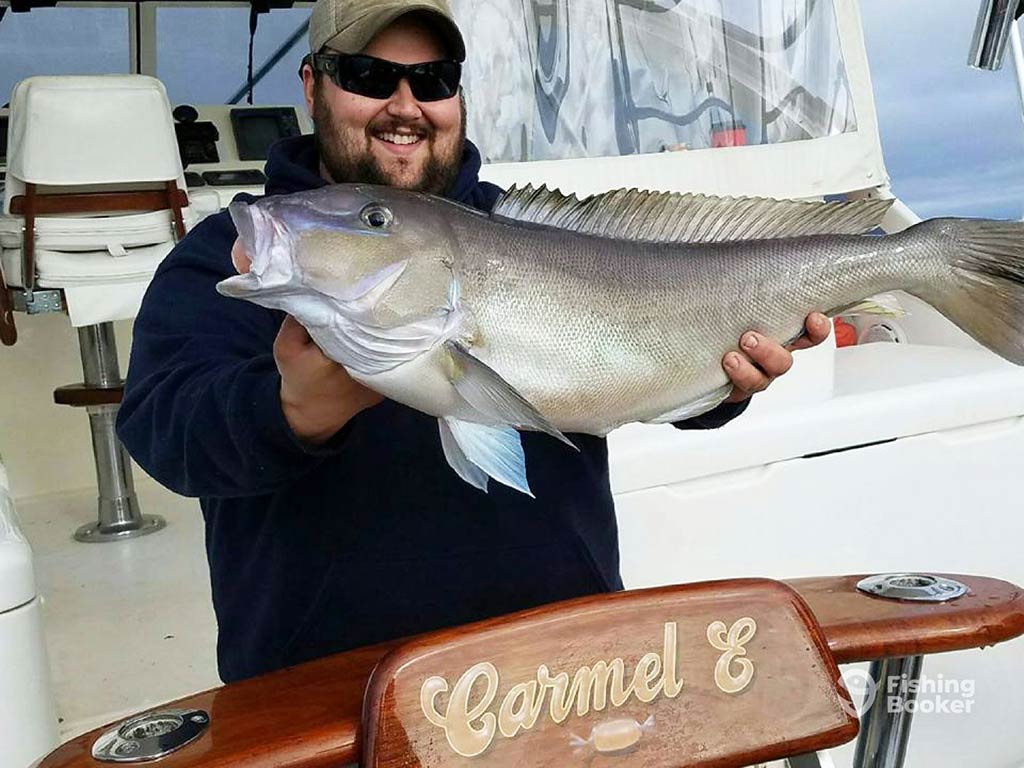
Golden Tilefish live deep in the ocean’s twilight zone. We’re talking hundreds – even thousands – of feet deep. That calls for specialized gear and some sturdy sea legs. But after just one bite, you’ll be hooked, because it feels like literally striking gold.
How to Identify Tilefish
Various kinds of Tilefish (Malacanthidae) inhabit the Atlantic, Pacific, and Indian Oceans. These deep-dwelling fish swim anywhere between 250 and 1,500 feet below the surface. Unlike Snapper and Grouper, which often hide near wrecks and reefs, Tilefish burrow into mud and cone-shaped piles of sand. Sometimes they cozy up in rubble and rock piles. Continental shelves and other dramatic drops in the ocean floor are usually where you’ll find them.
Tilefish are a popular deep sea fishing target in the Western Atlantic, where you can catch them from the Gulf of Mexico/America to the coast of Maryland. Less often, they appear as far south as the Caribbean and north up to Maine. The most common species in the Atlantic are Golden, Blueline, Purple, Blackline, and Sand Tilefish.
Before your head starts to spin, rest assured there are only two you really need to know: Golden Tilefish and Blueline Tilefish. These are the biggest and most sought-after species. And, lucky for you, they aren’t too hard to tell apart.
Golden Tilefish vs. Blueline Tilefish
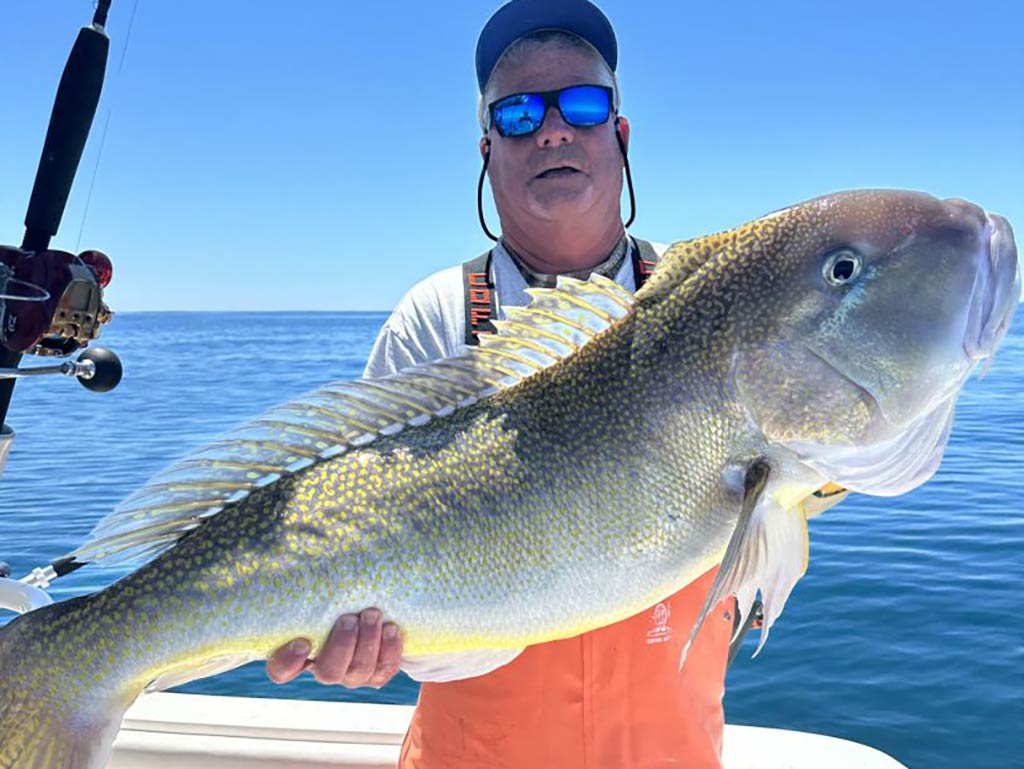
Golden Tilefish (Lopholatilus chamaeleonticeps) – also called Northern Tilefish – are indeed gold (or yellow) in color. They’re spectacular to behold when you reel them in from the deep and the sun strikes the shimmering spots down their sides.
A little confusing, however, is that Golden Tilefish are sometimes called Blue Tilefish, despite the fact that they aren’t blue. Should you have any doubts, just look for a rounded crest in front of their dorsal fins. This sets Golden Tiles apart from other species.
Their colorful looks have earned them the nickname “Clowns of the Sea,” but really, they’re no joke! Golden Tilefish commonly weigh 15–30 pounds, sometimes exceeding more than 50. The current IGFA All-Tackle record tops 68 pounds. And that’s an incredible weight to lift off the bottom of the ocean!
Blueline Tilefish (Caulolatilus microps) are sometimes referred to as Gray Tilefish, due to their blue-gray hue. A much better way to identify them, however, is by the bright blue lines running from their eyes to their lips. After all, this is how they got their primary name.
Bluelines are smaller than Golden Tilefish and usually weigh just 2–10 pounds. If you happen to catch one over 10 pounds, that’s a trophy!
Best Tilefish Fishing Spots
There’s no shortage of places to catch Tilefish along the Mid- and South Atlantic coast. The Gulf of Mexico/America boasts some of the country’s most productive deep sea fishing grounds. In fact, the number of options is enough to make your head spin! Here are a few key locations you shouldn’t pass up…
Gulf of Mexico/America

The Gulf of Mexico/America is a deepwater haven for both Golden and Blueline Tilefish. Landmarks such as the Mississippi Canyon and any area along the continental shelf are good places to drop a line for these fish. For relatively quick access to the Gulf’s deep sea fishing grounds, look for charter boats in cities like Galveston, TX, Venice, LA, and Destin, FL.
Tilefish regulations within state waters vary, but the season for both species is usually open year-round in federal waters. Tilefish are included in the 20 reef fish bag limit for federal waters.
Florida Keys

The Florida Keys are legendary for deep drop fishing, and Tilefish are a top target. Here, the combination of warm currents and varied bottom structure creates ideal conditions for these species. Just beyond the reef line, the ocean floor plummets, which gives local charter boats easy access to deep sea fishing. Key Largo, Islamorada, Marathon, and Key West are some of the best towns to launch from.
Tilefish regulations in Florida’s Atlantic waters are tighter than those in the Gulf. Golden Tilefish are open to harvest year-round in state waters, but they’re subject to an annual quota in federal waters, which means the season for them will close once that quota is reached. Blueline season in state and federal waters is open from May 1 to August 31, and bag limits apply.
Outer Banks (North Carolina)

The Outer Banks offer some of the best deepwater fishing on the East Coast. A full day charter can get you to the continental slope, where both Golden and Blueline Tilefish are abundant 600–1,200 feet down. Charter boats in Kitty Hawk, Manteo, Wanchese, and Nags Head all offer access to these fishing grounds. If you happen to be staying south of the OBX, Hatteras, and Morehead City are also situated near great deep sea fishing.
The season for Golden Tilefish in federal South Atlantic waters opens at the start of the year and closes upon reaching the annual quota, while Blueline season opens in May.
Norfolk Canyon (Virginia)
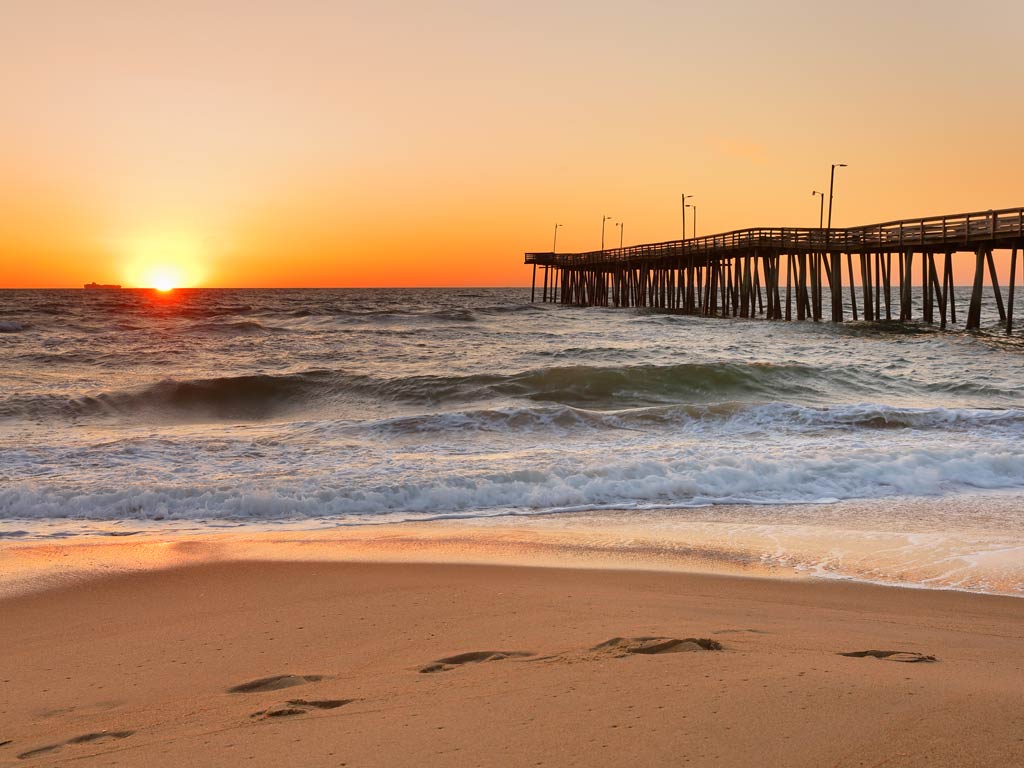
Up the coast, anglers in Virginia have access to Norfolk Canyon about 70 miles offshore. The underwater landscape changes dramatically where the upper continental shelf gives way to the abyssal plain, forging complex structures for Tilefish to call home. Needless to say, these are fertile fishing grounds for boats based in and around Virginia Beach.
The season for Golden Tilefish is open year-round in federal Mid-Atlantic waters, with a bag limit of eight per angler. Meanwhile, Blueline season runs from May 15 to November 14. Bag limits for Bluelines vary depending on whether you fish from a private vessel, charter boat, or party boat.
Hudson Canyon (New Jersey)

As far as submarine canyons go, it only gets better. Roughly 100 miles out from New Jersey lies Hudson Canyon, the largest submarine canyon off the East Coast. Naturally, this makes it a hotspot for deep sea fishing! The canyon’s steep walls and soft-bottom ledges create the ideal feeding grounds for Tilefish. Look for charter boats in Point Pleasant, Atlantic City, and Cape May to get you there. Mid-Atlantic fishing regulations apply, as described above.
How to Fish for Tilefish
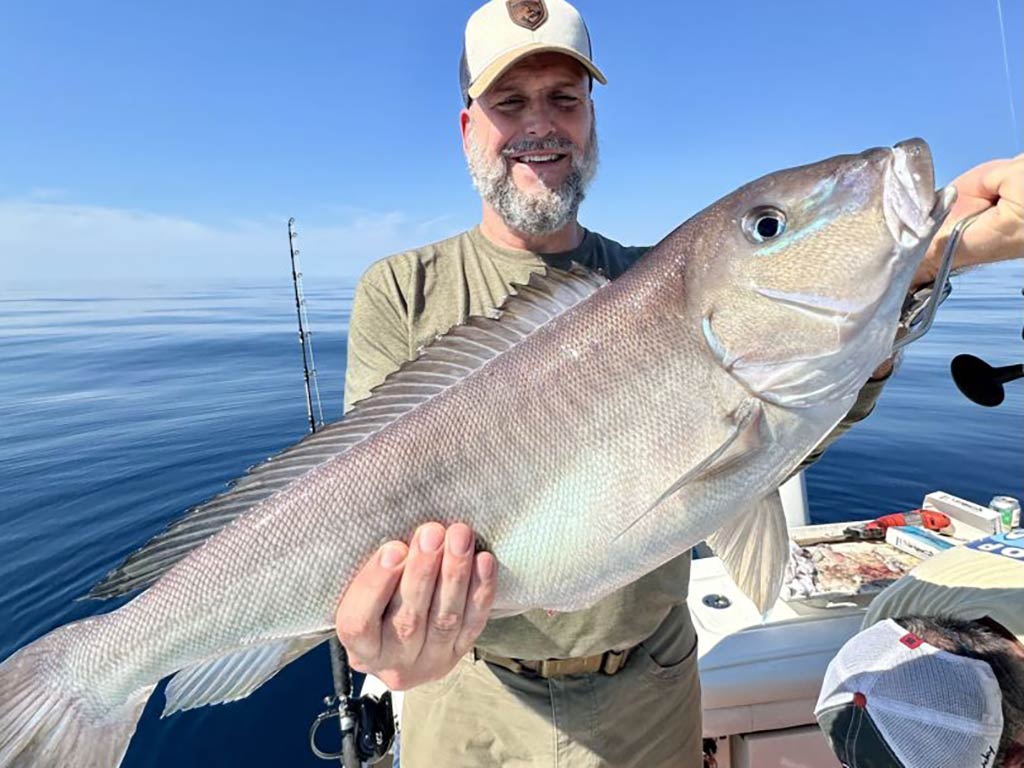
Since Tilefish burrow into the sand and muddy seafloor, they’re most likely to find your bait if you’re fishing right on the bottom. The only way to reach them is by deep dropping, a method of bottom fishing in water more than 500 feet deep.
You’ll usually drift over mud plains and ledges, allowing your bait to slowly drag across the bottom until it passes a Tilefish burrow. While less common, you can also jig for Tilefish by dropping your bait to the seafloor and then lifting it enough to let the current push it up and down.
The name of the game here is patience, since getting a bite can take time. Once you do hook a Tilefish, however, the bite is on, because these fish live in tight-knit colonies.
Tilefish Fishing Gear & Bait

Fishing thousands of feet deep requires more than your average rod and reel. Even if you don’t hook a trophy Tile, cranking it up to the surface is sure to be more of a workout than you bargained for.
Unless you’re an avid deep sea angler, we recommend booking a charter boat that comes equipped with the following gear. In addition to putting you on the fish, they’ll help you follow regulations and release your catch safely when needed using a descending device. Here’s everything you’ll need:
- Heavy-duty Rods and Electric Reels. Deep dropping calls for heavy-duty bottom fishing rods and reels capable of handling several hundred yards of main line. While you may have the option to try your luck with a manual reel, it’s common to use electric reels when targeting Tilefish deeper than 600 feet.
- Braided Line and Mono/Fluoro Leaders. You’re likely to use 50–80 lb braided line while fishing this deep, usually with an 80–100 lb monofilament or fluorocarbon leader to reduce visibility.
- Circle Hooks in sizes 8/0–10/0 are often used in tandem or multiple-hook rigs. The most popular setup is the chicken rig or dropper loop rig, with multiple hooks spaced along a leader (forming a “meat curtain”) and a 1–5 lb sinker at the bottom. It’s common to add glow beads or tubes near your hook to make your bait stand out in the ocean’s twilight zone.
- Fresh Bait and Glowing Lures. Tilefish love fresh, oily bait such as squid, cut mackerel, bonito, and sardines, but you can also catch them on artificials that mimic these. Soft plastic squids are a popular choice, as well as jigs that glow in the dark. To make these more effective, many anglers bait their rigs or add scented oils.
Lastly, regulations require anglers to use the aforementioned descending devices when releasing Tilefish in federal waters.
When to Fish for Tilefish

The best time to fish for Tilefish is usually during summer, when conditions out on the open water are most favorable. That said, you also need to plan your trip around the legal season for Golden and Blueline Tilefish.
In federal waters of the Gulf of Mexico/America, Tilefish season stays open year-round. Both species have seasonal closures in the Atlantic, which vary between the South Atlantic and Mid-Atlantic fishing zones. Refer to the NOAA’s Tilefish species page for the most up-to-date information on regulations in these areas.
Tilefish: Treasures of the Deep
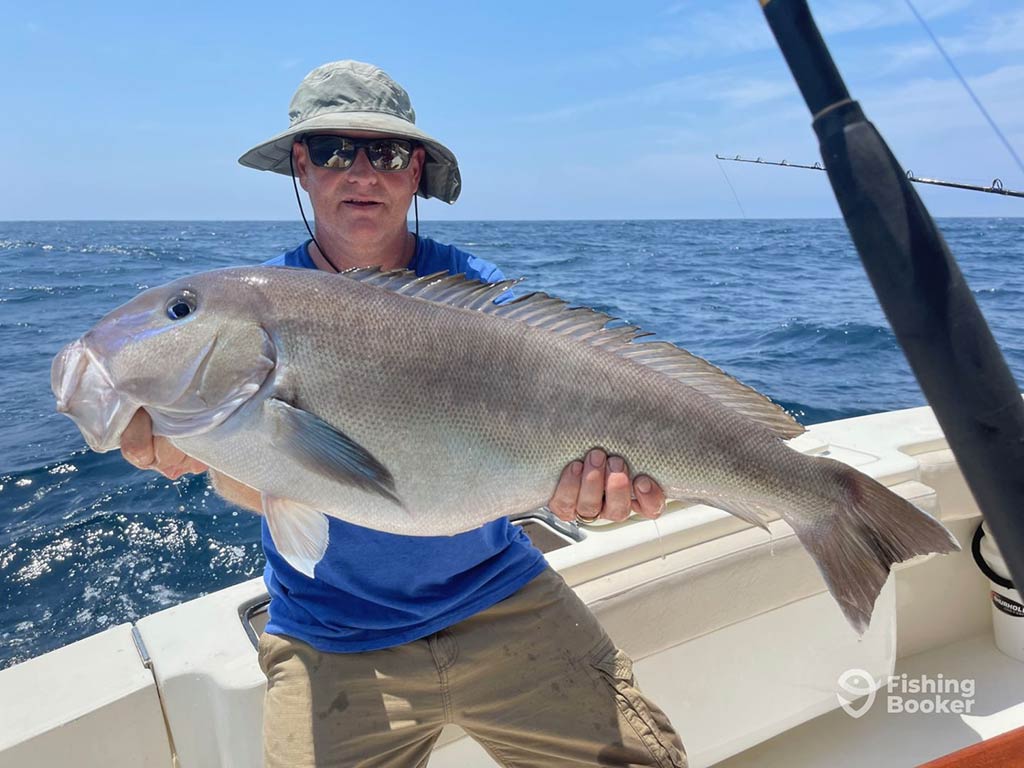
Tilefish are a sweet reward for the most persistent anglers. Fishing for them doesn’t rival the excitement of chasing down a big game fish, but it does require plumbing the deepest waters modern charter boats can reach.
Catching Tiles is worth the time and effort because these are some of the tastiest fish in the sea. Perhaps that’s why they’re guarded so far from the surface, like any treasure should be!
Have you ever landed a Tilefish on a deep sea fishing trip? We’d love to hear all your stories in the comments below!
